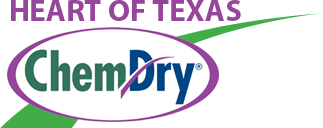The upholstery on furniture is just as susceptible to stains, odors, and debris buildup as carpets are, if not more so. Finding that perfect upholstery is no easy feat and once you have invested the time and money into it, you want to keep it as clean and spot free as possible; which is why we at Heart of Texas Chem-Dry would like to share the upholstery spot cleaning guide with you today.
Upholstery Fabric Spot Cleaning Code Grades & Process
1. Pre-clean. Before noting the fresh stains, if you are tackling the upholstery late in the game and the spots and stains are dry, vacuum the upholstery’s sides, back, cushions and all surfaces before cleaning. Utilize the various attachments to get into the cracks and crevices. Any soil or pet hair left on the upholstery will stain up when cleaner is introduced, giving a bigger mess to contend with.
2. Blot stain. Don’t scrub or rub. Always blot the spills quickly; avoid scrubbing or rubbing. Much like carpets, if upholstery gets rubbed and scrubbed during the efforts of removing the stain causing agent, you are only pushing it deeper into the soil.
3. Compatible couch cleaners. Know the upholstery and which cleaners are compatible. Find out the specific type of fabric that is comprised of your upholstery and know what kind of stain it is. Common upholstery fabrics include; cotton, wool, silk, acetate, linen, rayon, olefin, and acrylic just to name a few, as well as blends of these fabrics. Keep in mind that if the upholstery is aged, antique, or exotic blends, consider letting a professional handle treatment. If the tags are still intact, all the information concerning the upholstery is printed there.
4. Cleaning codes on the label. The furniture industry created care tags, usually found hanging in an inconspicuous place on the side of the furniture, or under seat cushions, that instruct how upholstery is treated. Below you will find the code and what they mean.
S: Clean a water free product, such as dry cleaning solvent.
W: Clean with a water based detergent.
WS: Clean with your choice of water based cleaner or a water free cleaner; depending on the type of stain.
X: Professional cleaning is required. Vacuuming and brushing is recommended but never use any type of upholstery cleaner on it yourself.
5. Upholstery is missing its tag. If you are uncertain be sure to never skip the test patch of the cleaner in an inconspicuous area. Some chemicals, even natural ones, can lighten colors or damage the fabric.
6. Types of sofa stains. The type of stain impacts how it is best treated. There ideal formulas for food and beverage stains, protein based stains, oil and grease stains, and other types of stains.
Liquids: Do not rub or scrub. Blot as much liquid as possible until no more moisture is being absorbed in your choice of dry paper towel or cloth. Work from the outer edge towards the center.
Solids or semi-solids: Use a dull edge, like a butter knife or a spoon, to scrap up the excess towards the center as you wipe what you pick up into a paper towel. Treat the liquid residue y blotting.
Dry Spills: Do not introduce water, as it could stain, use the vacuum to extract the agents, repeat until gone.
All purpose stain remover: Combine 1 part white vinegar and 2 parts water in a spray bottle and mist the stains. Blot in between applications to avoid over saturated and repeat until stain is removed. For greasy or oil stains, generously sprinkle baking soda or cornstarch and let it set for 20 minutes or until dry. Follow up with the all purpose cleaner but add 1 tsp of liquid dishwashing soap. Protein stains such as pet accidents is better treated with an enzyme cleaner if the above formula is ineffective.
Carpet Cleaning & More in Waco, Dallas, Harker Heights, Cedar Park, Allen & the State of Texas
If you continue to have problems with stubborn upholstery stains, call the experts of Heart of Texas Chem-Dry and let our pros get them out.




